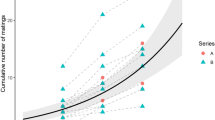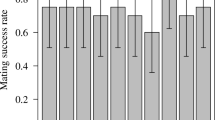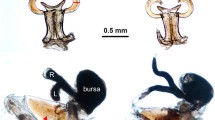Abstract
Sexual conflict between mating partners can give rise to strategies that are advantageous for one sex but harmful to the opposite sex. Usually, sperm donors develop (offensive) traits to enhance their chances in sperm competition, while sperm recipients evolve (defensive) traits that allow them to stay in control of who fathers their offspring. Here, we demonstrate that these processes are also at work in simultaneous hermaphrodites. The hermaphroditic earthworm Lumbricus terrestris uses 40 to 44 copulatory setae to pierce into its partner's skin, causing damage and injecting a substance from its setal glands. Experimental injection of the gland substance indicates that a refractory period may be induced. More importantly, removal of the copulatory setae shows that they influence the partner's sperm uptake. When the setae are present, more sperm are taken up and sperm are distributed more equally over the four spermathecae. We interpret this as a strategy that stacks the odds for the donor's sperm in fertilizing cocoons.




Similar content being viewed by others
References
Bishop JDD, Jones CS, Noble LR (1996) Female control of paternity in the internally fertilizing compound ascidian Diplosoma listerianum. II. Investigation of male mating success using RAPD markers. Proc R Soc Lond B 263:401–407
Breidenbach J (2002) Normalanatomie und -histologie des Lumbriciden Lumbricus terrestris L. (Annelida, Oligochaeta). Ph.D. Thesis, University of Muenster (Germany)
Chapman T, Arnqvist G, Bangham J, Rowe L (2003) Sexual conflict. Trends Ecol Evol 18:41–47
Cuadrado S, Martínez-Ansemil E (2001) External structures used during attachment and sperm transfer in tubificids (Annelida, Oligochaeta). Hydrobiologia 463:107–113
Darwin C (1871) The descent of man, and selection in relation to sex. Murray, London
Fedina TY, Lewis SM. (2004) Female influence over offspring paternity in the red flour beetle Tribolium castaneum. Proc R Soc Lond B 271:1393–1399
Feldkamp J (1924) Untersuchungen über die Geschlechtsmerkmale und die Begattung der Regenwurmer. Zool Jahrb Anat 46:609–632
Grove AJ (1925) On the reproductive process of the earthworm, Lumbricus terrestris. Q J Microsc Sci 69:245–290
Haase M, Baur B (1995) Variation in spermathecal morphology and storage of spermatozoa in the simultaneous hermaphroditic land snail Arianta arbustorum (Gastropoda: Pulmonata: Stylommatophora). Invert Reprod Develop 28:33–41
Hellriegel B, Ward PI (1998) Complex female reproductive tract morphology: Its possible use in postcopulatory female choice. J Theor Biol 190:179–186
Hellriegel B, Bernasconi G (2000) Female-mediated differential sperm storage in a fly with complex spermathecae, Scathophaga stercoraria. Anim Behav 59:311–317
Johnstone RA, Keller L (2000) How males can gain by harming their mates: Sexual conflict, seminal toxins, and the cost of mating. Am Nat 156:368–377
Koene JM (2004) Immunomodulation, allohormones and fertility. Med Hyp 63:1084–1085
Koene JM (2005) Love darts of land snails. Invert Biol 124:1
Koene JM, Chase R (1998) Changes in the reproductive system of the snail Helix aspersa caused by mucus from the love dart. J Exp Biol 201:2313–2319
Koene JM, Schulenburg H (2005) Shooting darts: Co-evolution and counter-adaptation in hermaphroditic snails. BMC Evol Biol 5:25
Koene JM, Sundermann G, Michiels NK (2002) On the function of body piercing during copulation in earthworms. Invert Reprod Develop 41:35–40
Koene JM, Ter Maat A (2001) “Allohormones”: A class of bioactive substances favoured by sexual selection. J Comp Physiol A 187:323–326
Koene JM, Ter Maat A (2002) The distinction between pheromones and allohormones. J Comp Physiol A 188:163–164
Koene JM, Ter Maat A (2004) Energy budgets in the simultaneously hermaphroditic pond snail, Lymnaea stagnalis: A trade-off between growth and reproduction during development. Belgian J Zool 134:41–45
Landolfa MA, Green DM, Chase R (2001) Dart shooting influences paternal reproductive success in the snail Helix aspersa (Pulmonata, Stylommatophora). Behav Ecol 12:773–777
Michiels NK (1998) Mating conflicts and sperm competition in simultaneous hermaphrodites. In: Birkhead TR, Møller AP (eds) Sperm competition and sexual selection. Academic Press Ltd., pp. 219–254
Michiels NK, Hohner A, Vorndran IC (2001) Dangerous liaisons in the earthworm Lumbricus terrestris: The importance of precopulatory mate assessment in relation to body size. Behav Ecol 12:612–618
Morgan MT (1994) Models of sexual selection in hermaphrodites, especially plants. Am Nat 144:S100–S125
Nuutinen V, Butt KR (1997) The mating behaviour of the earthworm Lumbricus terrestris (Oligochaeta: Lumbricidae). J Zool Lond 242:783–798
Olsson M, Shine R, Madsen T, Gullberg A, Tegelström H (1996) Sperm selection in females. Nature 383:585
Oumi T, Ukena K, Matsushima O, Ikeda T, Fujita T, Minakata H, Nomoto K (1996) Annetocin, an annelid oxytocin-related peptide, inducing egg-laying behavior in the earthworm, Eisenia foetida. J Exp Zool 276:151–156
Prosser CL, Zimmermann GL (1943) Effects of drugs on the heart of Arenicola and Lumbricus. Physiol Zool 16:77–83
Rogers D, Chase R (2001) Dart receipt promotes sperm storage in the garden snail Helix aspersa. Behav Ecol Sociobiol 50:122–127
Rogers D, Chase R (2002) Determinants of paternity in the garden snail Helix aspersa. Behav Ecol Sociobiol 52:289–295
Simmons LW (2001) Sperm competition and its evolutionary consequences in the insects. Princeton University Press, Princeton, NJ
Sims RW, Gerard BM (1999) Earthworms, notes for the identification of British species. In: Barnes RSK, Crothers JH (eds) Synopses of the British fauna (new series), no. 31 revised. Field Studies Council, Shrewsbury
Ward PI (1993) Females influence sperm storage and use in the yellow dung fly, Scathophaga stercoraria (L.). Behav Ecol Sociobiol 32:313–319
Ward PI (2000) Cryptic female choice in the yellow dung fly Scathophaga stercoraria (L). Evolution 54:1680–1686
Acknowledgments
We thank J. Lange, G. Sundermann, C. Mehlis and C. Levesque for technical assistance and H. Schulenburg, L. Schärer, T. d'Souza, S. Field and A. Ter Maat for valuable comments. This research was partly funded by a fellowship from the Alexander von Humboldt Foundation to JMK
Author information
Authors and Affiliations
Corresponding author
Additional information
Communicated by M. T. Siva-Jothy
Rights and permissions
About this article
Cite this article
Koene, J.M., Pförtner, T. & Michiels, N.K. Piercing the partner's skin influences sperm uptake in the earthworm Lumbricus terrestris . Behav Ecol Sociobiol 59, 243–249 (2005). https://doi.org/10.1007/s00265-005-0030-y
Received:
Revised:
Accepted:
Published:
Issue Date:
DOI: https://doi.org/10.1007/s00265-005-0030-y




